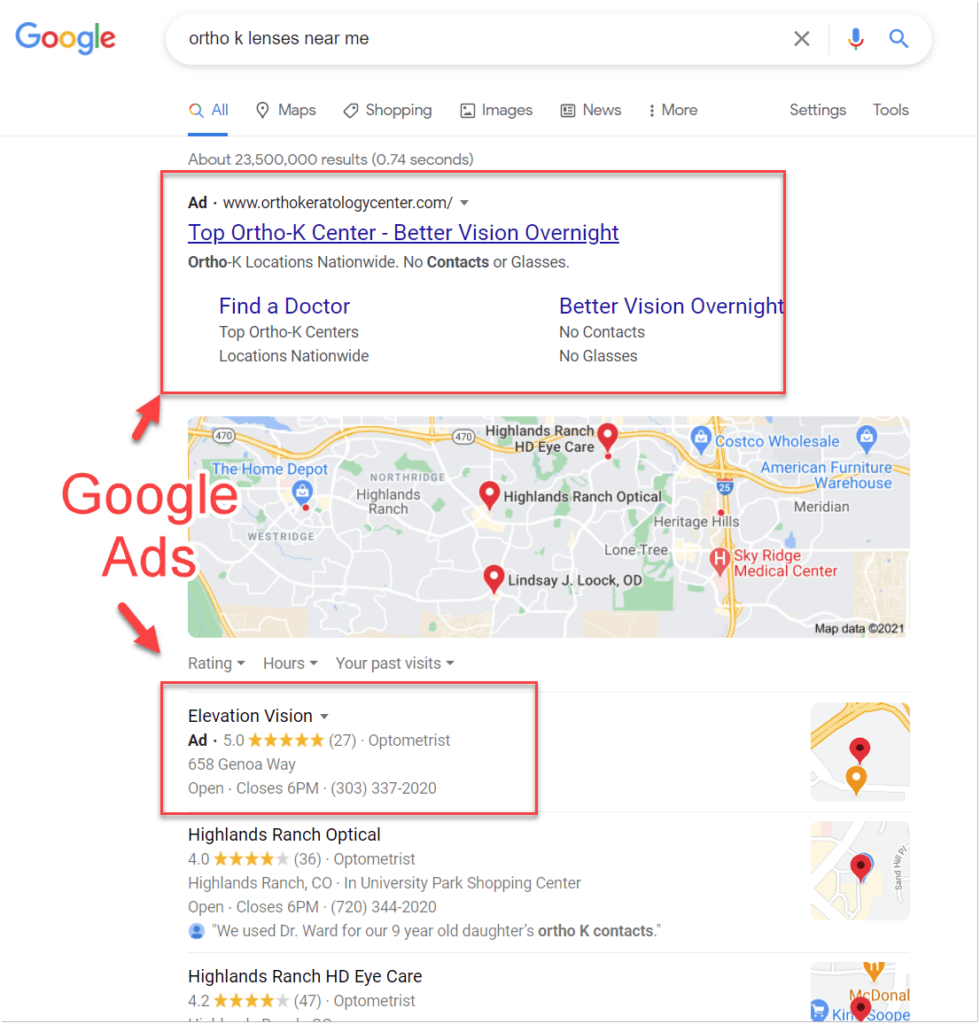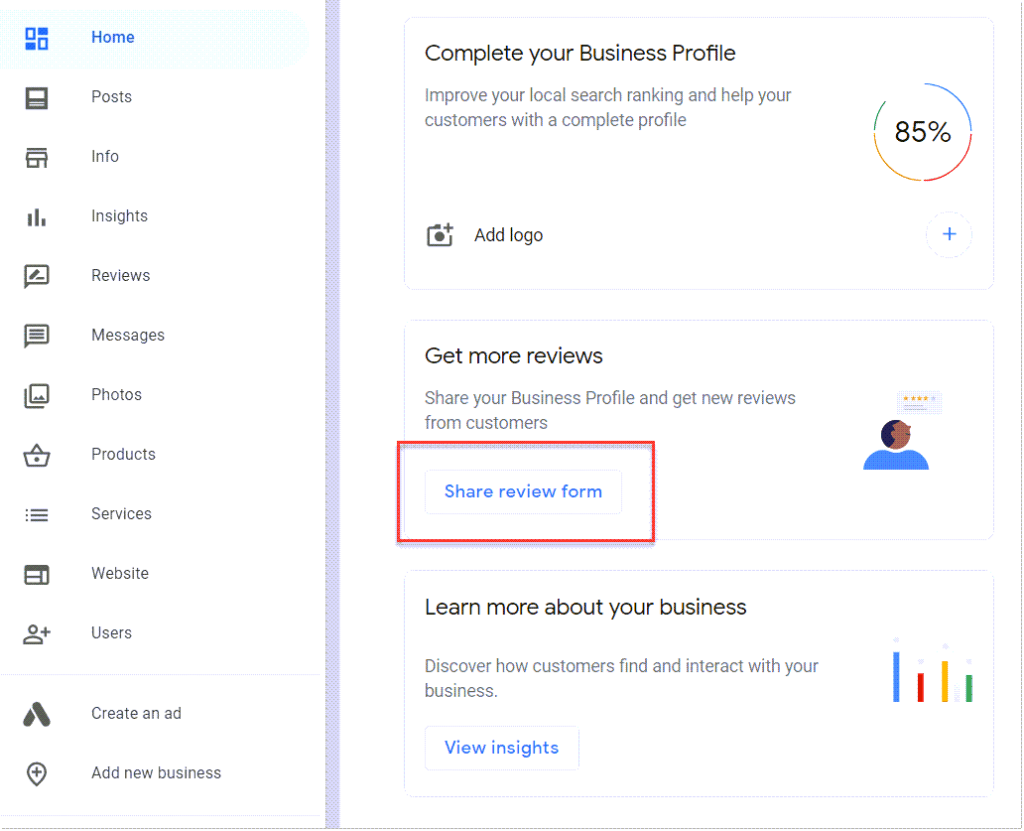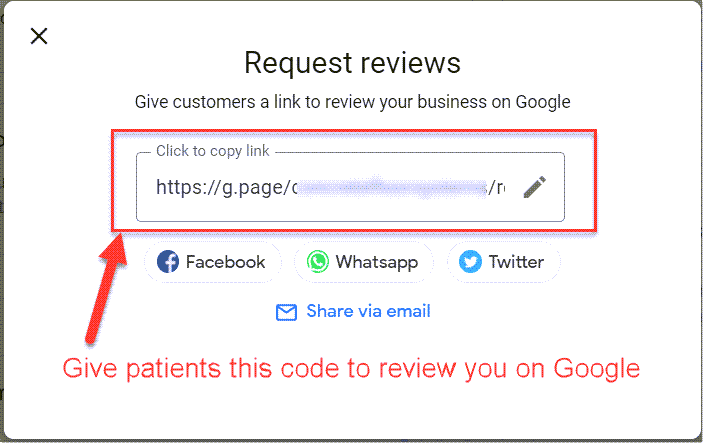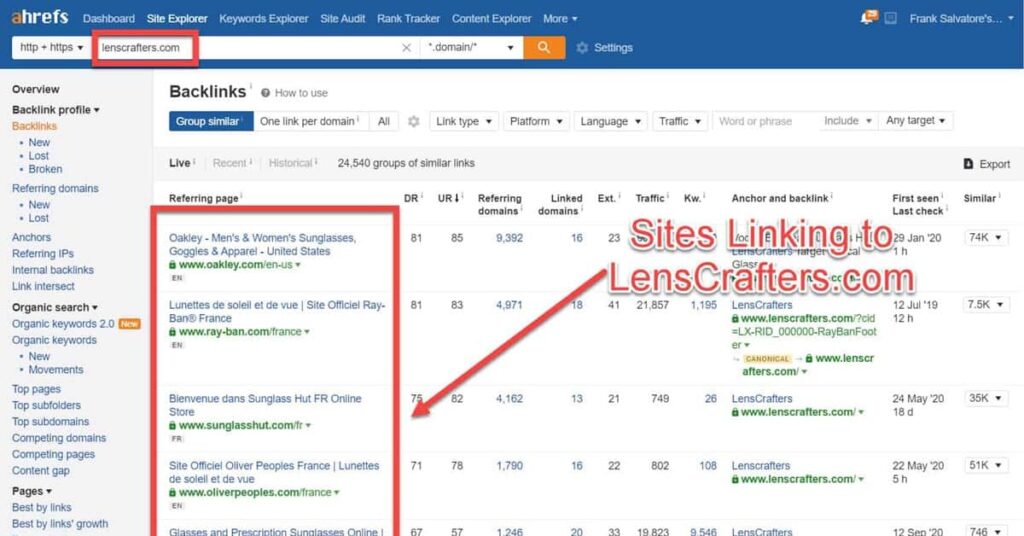Online Optometry Marketing
Getting more patients into your optometry practice can be a constant struggle for eye care business owners. Here, we’ve compiled a list of eye care digital marketing ideas that opticians can implement to jumpstart patient acquisition.
1) Optometry Website that Converts Prospects into Patients
Your website is one of your most important marketing assets. You must have a website for your optometry practice that converts. Most optometry practices already have a website, but oftentimes their website is unable to turn those prospective patients into satisfied paying patients.
Common problems with attaining website conversions include:
Bad Design
A poorly designed website can destroy all of your other marketing efforts. In order to convert your website visitors to patients, you need to have a professional-looking website design.
Avoid a website design that is too creative or trendy. The website design should be for your patients – and your prospective patients. It needs to be easy to navigate and allow site visitors to find what they’re looking for quickly.
An Example of Bad Web Design

Poor Content
Content marketing is a critical component of optometrist marketing. It is the process of producing helpful informational content for both patients and prospective patients. Usually this content is available on your optometry website.
Content marketing is crucial as it helps you to establish your expertise, build trust with potential patients, and increase your online visibility. By creating and sharing valuable, informative content related to eye health, vision care, and the latest advancements in optometry, you can educate your audience and position yourself as an authoritative figure.
This strategy can also improve your search engine rankings, which can make it easier for potential patients to find your practice online. Additionally, this engaging content can be shared across social media platforms, further expanding your reach and fostering a sense of community around your practice.
The bottom line is that content marketing helps you differentiate your practice in a highly competitive market, showcase your unique approach to eye care, and demonstrate your commitment to patient education and well-being.
Bad call-to-action
If your optometry site isn’t able to convert, it’s a pretty good bet that the call-to-action on your website isn’t clear. The call to get prospects to take action needs to contrast with the rest of the page. It also should be clear and located above the fold. It needs to be in a place where eye care patients couldn’t possibly miss it.
Additional Resources on Optometry Websites
FlexLeads creates sites that are specifically designed to convert prospects into patients. For more information, please see our websites for optometrists page.
2) Get Your Optometry Website Listed in Local Listings
Effective optometry marketing requires getting your brand listed in various places around the Internet.
Local Citations
Local citations are online listings that are meant for the general public and allow people to understand what your business is all about. For example, one of the citation sources where you should list your optometry practice is on your Google Business Profile (Formerly Google My Business – which is discussed in depth below).
The local citation for your eye care practice will contain your brand name, address, phone number, and website URL. The listing may also contain photos of your practice and some other basic information.
Local citations are a ranking factor for ranking on the search engine results pages and in the Google map pack. Fortunately, getting your brand listed on local citations is a very time-consuming process. There are vendors and agencies that can get this done for you at a reasonable price.
If your practice isn’t already listed in some of the most important local listings, you need to start the process of getting your listing completed today. Resources you can get started with are at the end of this article.
Google Business Profile
Your Google Business Profile is one of the most important local citations for your practice and is essential for effective optometry marketing. It’s the only way for people to find your practice on Google Maps. Here are some of the key items that you can add to your Google Business Profile Listing:
- Website URL and phone number
- Business category (up 5 available categories)
- Hours of operation (for each day that your practice is open)
- Business Address
Google Posts
You can also post updates about your business using Google Posts. Google Posts are a great way to connect with your patients and keep them informed of specials or events that they may be interested in.
3) Use Google Ads Paid Search
Optometry marketing using Google Ads is probably the quickest way for optometrists to acquire new patients. Google Ads appear above the organic (free) search results and at the bottom of the page.
With Google advertising, your ad will appear in the search results for site visitors who are searching for your eye care services.
In the example below, someone has searched for “ortho k lenses near me”. You can see that a Google Ad is on the very top of the page followed by the Google “Map Pack” which also contains another paid ad. Usually, advertising units appear at the top and bottom of the page, but can also appear within the map pack.
Digital Marketing with Google Ads Example: Ortho K

The Google Search Terms Report is found under the Keywords tab
When someone clicks on your Google ad, Google charges the click cost to your Google Ads account. This is called pay per click (PPC) advertising.
PPC ads work like this: when a prospect clicks on your ad, they are taken to a page on your optometry site that most closely matches their search. In our example, we would direct the person who clicked on the ad to the Ortho K page because this page very closely matches what they are searching for.
Google Ads Targeting Options
Google Ads has amazing geographic and demographic targeting options that you can take advantage of to reach your ideal patient.
Geotargeting
This allows you to target people within a specific radius of your optometry practice. You obviously only want to spend money on advertising for prospects who are geographically close enough to make it to your practice.
Demographic Targeting
Gives you the ability to target your ads to people based on demographics. For example, you can target specific ads based on age, gender, or household income. This way you get the right ad in front of the perfect prospective patient.
4) Facebook Ads
Facebook ads are another great way to advertise your optometry practice. Since Instagram is owned by Facebook, you also have the opportunity to advertise on Instagram with Facebook Ads.
Facebook ads appear in the news feed on your Facebook page and in the sidebar. Facebook has multiple types of ad formats including Image Ads, Video Ads, and Carousel Ads.
Image Ads
Image Ads are images with some copy. They can be text-based or contain a video. Basic advertising gets your optometry practice in front of your Facebook fans on their news feeds.
Video Ads
Video Ads are a great way to get in front of your target audience. People can watch your optometry video and then follow an advertisement that you’ve placed on the end of the video ad, or they can swipe up to visit your optometry site.
Carousel Ads
Carousel Ads are a great way to showcase several different products and services in one ad. You can include up to 10 images or videos in a carousel ad – each with its own link. For example, you could promote a special that includes a free pair of glasses with an image ad, and a video ad for an eye exam and glasses.
One disadvantage of optometry marketing with Facebook Ads is that unlike Google Ads, people aren’t actively searching for your services. This makes using Facebook advertising more of a branding strategy than a direct response strategy (like Google Ads). People may have to see your ad a few times before your branding efforts pay off and they make contact.
This slight disadvantage is outweighed by the Facebook advertising targeting options. Facebook has the most advanced demographic targeting options of any advertising platform. You have the ability to target by interests, age, gender, and more.
5) Implement SEO for Your Practice to get More Business
Search Engine Optimization (SEO) is the process of making your website more visible to search engines. The more people that are able to find your optometry practice through search, the more potential patients you will have for your practice.
We go into great depth on this topic on our SEO for Optometrists page – check it out for more information. Here, we’ll touch briefly on keyword research and backlink building for optometrists.
Keyword Research for SEO
Keyword research for search engine optimization involves determining what people are searching for that is related to your optometry practice. After you determine the terms that people are looking for, you’ll want to start optimizing existing pages on your website with those terms. You’ll also want to develop new, relevant content that satisfies those search keywords.
Backlinks for SEO
Links to your website are like votes for your website’s search engine rankings. The more votes you have (votes are in the form of links), the higher your website ranks.
Healthcare website owners get links in several different ways. Getting Backlinks for your website involves building relationships with other websites and blogs that are relevant to your optometry practice in order to get those valuable links.
One key method of obtaining backlinks is guest posting. Guest posting places you in front of the new blog readers or potential eye care patients by publishing your unique insights on their blog. First, you’ll want to find websites or blogs that are relevant to your optometry practice. You should thoroughly read the blog content and see if there’s a place where you could be helpful with your input. Building relationships with other website owners helps tremendously in this effort.
6) Reviews from Patients
A key element of your digital marketing strategy for any healthcare provider is to have a system to get patient reviews. Patients look at reviews – according to Bright Local, 87% of consumers read online reviews, and only 48% of consumers would do business with a company that had a rating below four stars
When people search for your practice, they will see your Google listing where your Google reviews are prominently displayed. They’ll also see reviews from other sources including Yelp, Facebook, and niche review sites like ZocDoc.
Your office must make obtaining patient reviews part of the checkout process. Just ask for an online review from each patient, or better yet, send them a direct link to review your practice on Google or Yelp.
Your office will get occasional bad reviews from patients (or even fake reviews from people or bots that weren’t even patients). The best way to combat these bad reviews is to get a steady stream of reviews from your patients. Another benefit of consistently getting new reviews is that 73% of consumers in the Bright Local study only pay attention to reviews written in the last month.
How to Get Reviews
Your Google Business Profile has a direct link that you can send to people electronically. If they’ve opted into texts, you can text it to their phone or send it in an email after their visit has concluded.

Google makes it easy to get a review link to provide to customers from the Google Business Profile interface

You can also ask for Facebook recommendations. Note that Yelp does not allow companies to solicit reviews for its platform.
Should Optometrists Respond to Reviews?
For most industries, it is highly recommended to respond to reviews to show that ownership is proactive in dealing with customer feedback. Optometrists obviously are bound by HIPAA regulation and it is murky as to whether or not responding to a review breaks HIPAA guidelines as it implies the original reviewer is a patient of the practice.
7) Email Marketing and Texting
Optometrist marketing with Email is a great way to reach your optometry patients on autopilot. The key is to add value by being informative. Provide good insights and articles that your patients would find useful. For example, many of your patients may find articles about at-home eyecare useful.
Your marketing approach with email must be subtle. You can keep your patients informed of any promotions or specials that are being offered in your office. Just make sure that you add value first.
Another huge advantage of email communications is patient recall. Let your patients know when they are overdue for their next eye exam or procedure. Keep patients from missing their appointments by communicating with them electronically to avoid no-shows.
There are a number of relatively inexpensive email newsletter marketing services that you can use like Drip or MailChimp.
8) Social Media Marketing
You can use social media platforms like Twitter, Facebook, LinkedIn and Instagram as optometry practice marketing tools. At the very least, you should create an account for your business on all of these platforms for branding purposes. Don’t link from your main website to any social media platform website unless it is kept current with updates.
A word of warning – marketing using social media platforms can be very time consuming without much upside unless you have a detailed plan.
- Facebook – Updating your Facebook business page with office photos, events, and video testimonials can paint your office in a positive light.
- LinkedIn – LinkedIn is a great social media platform for networking and referrals with other medical professionals (e.g. general practitioners or ophthalmologists) who offer services that complement your offerings.
- Instagram – Like Facebook, you can update your Instagram page with the latest photos and videos of your optometry practice.
- Twitter – Twitter is can be used as a public relations platform for your business. Tweets can include images and videos from your office, how-to articles, and updates about upcoming events.
9) Website Analytics
You need to have an analytics program on your website. You can use a free program like Google Analytics – although Google’s analytics offering is geared more towards large ecommerce Google has its own Analytics program – which is actually quite complex and is geared towards large e-commerce businesses. You may prefer to consider a relatively inexpensive program (like Plausible Analytics) – which will is easy to read and will give you all the data you need for your optometry business.
Analytics play a crucial role in measuring the effectiveness of all the SEO, social media, and paid traffic strategies that we’ve discussed in this article. By implementing robust analytics tools, you can gain valuable insights into your website’s performance, user behavior, and the success of their marketing efforts.
For SEO, analytics help track important metrics like organic search traffic, keyword rankings, bounce rates, and time spent on site, allowing you to refine your content and website structure for better search engine visibility.
In terms of paid traffic, analytics provide detailed information on campaign performance, including click-through rates, conversion rates, cost per acquisition, and return on ad spend. This data helps you to make data-driven decisions, to allocate your marketing budget more effectively and focus on the channels and strategies that yield the best results.
Traditional Marketing Ideas for Eye Doctors
At FlexLeads, we focus exclusively on the Internet marketing to grow your business. That said, traditional optometry marketing has its place. It can be a proven, cost-effective way to bring in new patients to your business.
1) Referrals
Getting existing patients to refer new patients to your business is an excellent marketing strategy. There is no stronger endorsement than a referral from a trusted source. You can create a referral program that provides an incentive to patients for referring friends and family to your optical practice. You can offer incentives like a discount on their future visit or even a gift card. You can also offer incentives to the new patient who was referred by the existing patient.
2) Sponsorships
Sponsoring local events and charities is a marketing tactic that can provide a big boost to your optometry practice. You’ll have to do a cost-benefit analysis before committing, but sponsoring real-life events can be a big boost to your online presence.
Take photos and video of the event and distribute the media to your social media channels and website. Prospective patients will see that you’re a compassionate active, compassionate member of the local community, and event/charity participation will paint your office in a very good light.
An additional benefit of sponsorships is the opportunity to get backlinks – which are so vital for search engine optimization and Local SEO purposes (ranking well in search engines). When vetting sponsorship opportunities, try to determine if getting a link to your website is a possibility.
Additional Help and Resources
FlexLeads Optometry Marketing Services
If you’re an optometrist, we can help you get more patients with our healthcare marketing services. Your optometry marketing strategy would involve building or optimizing your website, taking advantage of paid search advertising, and in many cases implementing social media marketing. These efforts will not only encourage direct response from prospects, but it will also help to build brand awareness for when prospects need your services in the future. Contact us for more information.
Other Services
Digital Advertising Services
Citation Building
Many marketing agencies – including FlexLeads – offer citation building to clients. There are also citation building services that you can contact directly. BrightLocal and Whitespark are both well-respected citation building services.
4 Website Citations / Listings you Should Claim Right Now:
Web Design
Don’t Make Me Think – This book by Steve Krug discusses how important it is to have a web design that is intuitive to your website visitors. The design shouldn’t force them to think on how to properly use your website – or else they’ll leave and go to another healthcare provider.

